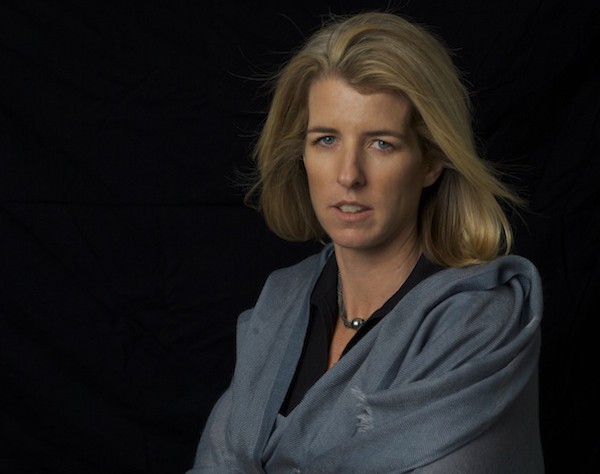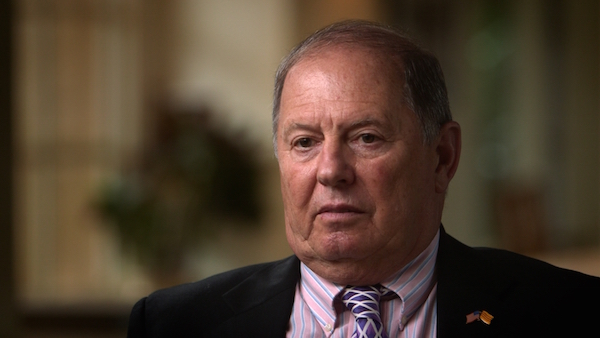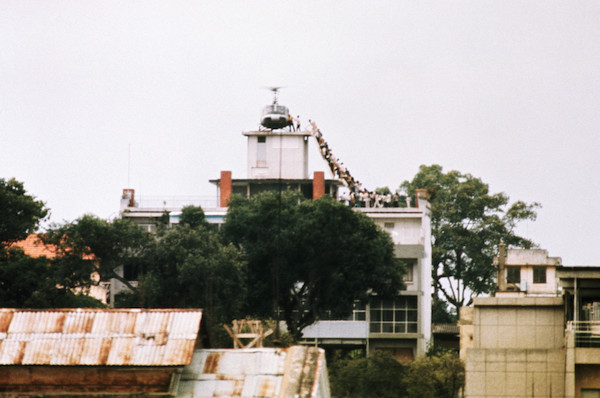Last Days in Vietnam, from acclaimed documentary film director and producer Rory Kennedy tells the suspenseful tale, that I guarantee you have not heard before, of our precipitous and chaotic exit from Vietnam in April, 1975. The documentary which has been short-listed for the Academy Award plays like a feature film that will keep you on the edge of your seat from start to finish.
It may be hard to remember the humiliation and disrespect showered upon returning Vietnam veterans in the aftermath of the war that our nation abandoned. Last Days of Vietnam provides an overdue correction in spotlighting some of the true heroes of that conflict. As the youngest of the eleven children of Robert F. Kennedy and Ethel Kennedy, Rory Kennedy was born six months after the assassination of the father she never met. With Last Days in Vietnam, she honors her father’s legacy with a film that is very much a continuation of the work he began.
Rory Kennedy is an Emmy Award winning independent documentary filmmaker and cofounder and president of Moxie Firecracker Films. Her past films include Ethel; Ghosts of Abu Ghraib; Thank You, Mr. President: Helen Thomas at the White House; American Hollow; A Boy’s Life, and Pandemic: Facing AIDS. I was honored to speak with this gifted filmmaker during her recent sojourn in San Francisco.

Photo by Lyndie Benson, courtesy of Moxie Firecracker Films.
Sophia Stein: What was your inspiration for this very enlightening documentary?
Rory Kennedy: Vietnam was part of my consciousness from a very young age because my father ran for President in 1968. He very much got into that race because he was against the Vietnam War. He wanted us out of Vietnam. I have always been very interested in Vietnam as a seminal moment in our nation’s history.
Sophia: Last Days in Vietnam provides a very unique and singular approach to a significant chapter of our nation’s history in Vietnam. It is a story that I have not heard told before. How did you discover this particular angle of approach?
Rory: It was about two and a half years ago, and we were on the brink of getting out of Iraq and Afghanistan, so I thought it would be interesting to look at the final days of Vietnam to see if there were any lessons to be learned about how one gets out of a war that one hasn’t really won. As I learned more about what exactly transpired during those final days, I felt that it was an incredibly dramatic story. I was shocked by how much I didn’t know — and by how important it seemed.
Last Days in Vietnam was supposed to go out to ten cities, and it has just exploded theatrically. It has played in about one hundred and twenty theatres to date. Seeing the responses from audiences all across the country — from politicians that we all know and from historians, many of whom focus exclusively on Vietnam, yet who did not know this story — has reinforced that this is an important story that had not been told before.
Sophia: How did you go about identifying subjects to interview in recounting the history?
Rory: In our research, we uncovered the story of the U.S.S. Kirk, of the Chinook helicopter, and of Richard Armitage saving thirty-thousand people. I became hooked on telling the larger story through the prism of what these Americans were doing to help save the South Vietnamese on the ground. I started researching if there were other stories of Americans saving Vietnamese and uncovered one after another, after another. The stories that we recount in the film are significant, but there are many, many, many more that we didn’t tell.

Photo courtesy of Moxie Firecracker Films.
Sophia: U.S. Army Captain Stuart Herrington comes off as such a principled man —
Rory: Stu was right at the heart of the story that I wanted to tell. I actually interviewed him pretty late on in the process, maybe two-thirds into it. We had already started editing, and we had a skeleton of what the film would look like.
Sophia: You had the sense that the military stationed in Saigon were beholden to American Ambassador Graham Martin, this idealistic southern gentleman who was reluctant, almost beyond reason, to concede defeat. They all knew that what was happening on the ground was not matching with the Ambassador’s visions of a potential victory. The Ambassador tied their hands for a very long time. Even so, as Herrington relates the Ambassador’s role in all of it, he does so with such diplomacy, respect, and empathy for that man and his legacy — even while Herrington was directing black ops under the Ambassador’s nose. I found that dynamic of reverence, paired with disobedience in service of personal conscience, profoundly interesting.
Rory: It is a question of whether that level of decision-making could happen today? I’m not sure that it could. I think, in part, that they were able to do what they did because communications were not as available as they are today. Officials were making a lot of decisions on the fly because they actually couldn’t get in touch with people in a timely fashion to get the approvals to get something done. In this day and age, there might be a situation where you’re under fire and you have to make a decision on which you cannot consult, but I don’t think that you could take thirty-thousand Vietnamese on a flotilla of ships and arrive in the Philippines without having mentioned it to anybody.

April 29, 1975. Photo courtesy of Gerald R. Ford Presidential Library.
Sophia: How did you court Henry Kissinger to participate as an expert in the film?
Rory: He was the hardest person to get to agree to appear. I think that Kissinger has been asked to take part in a number of documentaries where he doesn’t come across very well, so he didn’t really see the upside of doing it. I really just wanted to tell the story about the last days in Vietnam, to really understand what the events were. I just wanted the facts. It’s one thing if you are trying to convince somebody and you know that you are going to hang them out to dry, and it’s another thing to try to convince somebody because it’s the right thing to do, because they are the keeper of the historical record. Kissinger kept saying “no,” and I just kept persisting. Finally, he agreed to give me a half and hour. I probably interviewed him for an hour and twenty minutes.
Sophia: The archival footage in the film is remarkable.
Rory: The archival footage was a huge priority to me. I did not want to do reenactments, recreations or rely on a lot of animation or other visual tricks, so I invested in a team of really good archival researchers – the kind who don’t just call ABC Evening News, and say, “Do you have any footage of the last days in Vietnam?,” but actually go to the houses and the source material. We were able to find some great footage that way.
And then, we got lucky. There was a fellow who worked for the historical and preservation unit of the U.S. Navy, I was talking to him about how I wanted to profile the Kirk in this film, and he came back to me, “You know, I was talking to a sailor who was on the Kirk, and he said that he was up in his attic four months ago and came across a box of super-8 undeveloped footage. Would you have any interest in that?” “Yes.” So I called the guy up the next morning. I was back in California, he was on the east coast, and he was very protective of the film, so he wouldn’t FedEx it out to me. So I flew him out to California! It could have been nothing … We developed it, and it was a treasure-trove. The footage of the helicopters being pushed over the ship, that’s his footage. The footage of the Chinook is his. The sequence of the Armitage, of the flotilla and all of those over-crowded ships at sea, the lowering of the Vietnamese flag and the raising of the American flag at the end of the film, that was all his footage.
Sophia: I noticed that a lot of the story was told through a very intelligent pairing of sound with those stirring images. What was your approach in working with your sound designer to achieve that effect?
Rory: We had a great sound designer named Joe Milner, with whom I’ve worked with on a number of films. Also, I think Gary Lionelli did a great job with the score. My goal was to have audiences go through this experience as though they were there. I wanted to really transport you to Saigon in 1975. Early on when they’re toasting the peace accord in photographs, you hear the clinks of glasses. You’ll notice, for example, in the Chinook story, after throwing his children out the door of the helicopter onto the ship, the father then leans the helicopter over to the right, and he jumps out the left side as the helicopter goes crashing into the ocean. That’s a photographic sequence, but we used sound to create explosions when the helicopter goes down. I think that kind of sound helps you feel like you’re there. Hopefully, you’re sitting at the edge of your seat wondering, “What is going to happen to this person?” “Oh my God, is that person going to survive?” “Is this person going to get out of the country?”
Sophia: It was so effective. I really was on the edge of my seat.
Rory: It’s Vietnam. And I think everybody’s like, “Do we need to go see another film about Vietnam?” “Haven’t we seen everything that we need to know about Vietnam?”
Sophia: I was a child at that time and my knowledge of the specifics of that period of history is somewhat limited, so I appreciated how your film helps to illuminate some of those specifics. What was an epiphany for me was how the peace accord and the potential for a two-state solution may have collapsed as a consequence of Watergate and Nixon’s fall.
Rory: Who knew. We should have kept Nixon. [She laughs with sarcasm.] Nixon, who in this day and age, is considered “a progressive.”
Sophia: I know that you were a big supporter of Obama’s in 2008. Has he seen Last Days in Vietnam?
Rory: Not that I’m aware of, but hopefully, he will. The night that President Obama was preparing to give his ISIS speech, George Packer of The New Yorker wrote a nice article saying that he “should watch Last Days in Vietnam beforehand,” but I’m not sure that the President got to it.

a half-mile from the U.S. Embassy. April 29, 1975. Photo by Bettmann/Corbis.
Sophia: What kind of epiphanies did you have in the making of the film?
Rory: I was taken by how vividly the story illustrated a stark fact: that in the heightened madness of wars fought by remote policymakers and unmanned technology, heroism is no longer the provenance of stoic generals or conquering emperors, but of ordinary men in extraordinary circumstances. Here were junior officers faced with a clear moral choice—the duty of following orders or to save as many lives as they could, consequences be damned. Aboard the Kirk, they chose honor over duty. Would any of us, faced with similar circumstances, have the courage to make the same choice?
We’ve all seen the iconic image of the helicopter on a roof that final day, but few people know of the bravery of so many American men and women whose loyalty and heroism saved the lives of a great many at-risk South Vietnamese. Amidst one our country’s most shameful moments, there was no shortage of courage. It actually makes you feel proud for a moment in Vietnam — which is profound, in and of itself.
By the time 1975 came around, there were very few good options available to the U.S. government as to what to do. So what that says to me is that the time to make smart and strategic choices is before you get into a war. Once you get in, war can take on its own momentum and go in a whole range of directions that you cannot control. I think that’s an important lesson.
I think the story also raises questions about our responsibility to people on the ground when we leave. Because when we left on April 29, 1975, we were out of there. We left behind Dam Pham, [Lieutenant, South Vietnamese Navy], who worked with us, whom we promised to get out. He ended up spending thirteen years in a re-education camp, and we didn’t even think twice about it. In the end, I think it is a reminder of the human cost of war on a basic level.
At around the same time as I was researching all of this, the New York Times published a series of stories, including a moving Op-Doc by filmmaker Beth Murphy, about how former Iraqi employees of the U.S. government were being targeted for assassination. History may not repeat itself, but it certainly does echo. As I read those stories it occurred to me: if I made this film, it wouldn’t be just a historical documentary, it would be a living, breathing history lesson of keen relevance today.
Top Image: Aboard the USS Kirk, crew members signal the Chinook to hover over the deck and drop its passengers out. April 29, 1975. Photo courtesy of Hugh Doyle.

![LDIV_TheatricalPoster-Flat_v3[2] copy](https://www.culturalweekly.com/wp-content/uploads/2015/01/LDIV_TheatricalPoster-Flat_v32-copy.jpg)